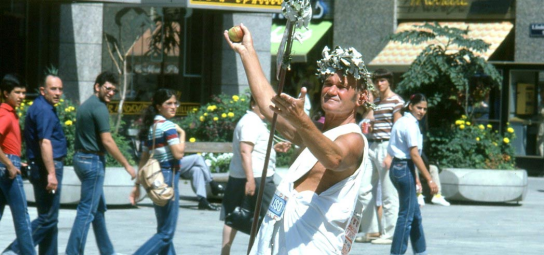For this activity you'll watch a very short video clip in German. Professor Karl Vocelka, an Austrian historian, describes how ritual demanded that the corpses of Habsburg kings and emperors were buried according to some very strict rules.
You can watch the video clip in German with either English or German subtitles or, if your German is intermediate or advanced, you might want to try watching the clip without subtitles. The language level is approximately appropriate for an Open University Level 2 language course, such as Motive (L203).
Choose a video
Question:
Where were the different parts of the Habsburg bodies buried and why were they buried separately?
Answer:
Wenn ein Habsburger gestorben ist, wurden zunächst einmal aus rein praktischen Gründen die Eingeweide entnommen, denn die beginnen zunächst zu verwesen und würden also einen sehr unangenehmen Geruch bei den Begräbnisfeierlichkeiten verbreiten. Dann hat man das Herz entnommen. Das Herz gilt als der Sitz der Seele, und dieses Herz wurde im Sinne der barocken Frömmigkeit in der Augustinerkirche, der Hofkirche, bei den Augustinern begraben. Dort gab es ein Haus, das angeblich die Engel aus dem Heiligen Land nach Loretto in Italien gebracht haben. Das Haus Mariens. Und bei diesem Haus wurden die Herzen bestattet. Und der Rest des Körpers wurde dann feierlich in der Kapuzinergruft begraben.
Translation:
When a Habsburg died, first of all - for purely practical reasons - the intestines were removed. They start decaying first and would have exuded a very unpleasant smell during the funeral ceremonies. Then the heart was removed. The heart is seen as the seat of the soul, and this heart was then – following baroque devotional rites – buried in the Augustine church, the imperial church, with the Augustinian monchs. There was a house, allegedly brought by angels from the Holy Land to Loretto in Italy, the house of Mary. And in this house of Mary the hearts were interred. And the rest of the body was then ceremoniously buried in the Capuchine crypt.
Activity
1. Choose which version of the video clip you want to watch: German, German with German subtitles, or German with English subtitles.
2. Answer the following two questions about the video.
a) Habsburg bodies were divided into different parts for their burial. How many different parts were there?
Choose from: 2, 3, 7 or 77.
b) Which reasons are given for interring body parts separately? Choose all that apply.
Choose from: Security, political power, practical considerations, religious devotion, dynastic reasons and health.
3. Reflect: Which version of the video is easiest to watch? Can watching a German video with English subtitles help you increase your German vocabulary? What about German captions alongside the German voice – does this help you to learn German?
4. Share your thoughts and comments with others in the comments below.


Rate and Review
Rate this activity
Review this activity
Log into OpenLearn to leave reviews and join in the conversation.
Activity reviews